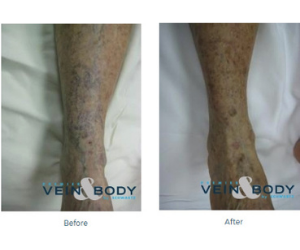Spider Vein Treatment Has No Downtime
Patients can return to normal activities immediately post-treatment. However, during the first 36 hours, patients should not do anything that will significantly increase their heart rate, so they should avoid major exercise such as squatting, heavy lifting or running. Spider vein patients are required to wear medical-grade compression hose for a period of time post-treatment to keep the veins collapsed and to help their legs heal. Dr. Schwartz also advises recently treated spider vein patients to avoid prolonged sitting or standing in one place for more than 1-2 hours at a time, and to continue frequent walking.
Four to Six Weeks Post Spider Vein Treatment
The treated spider veins will slowly begin to fade over the course of several weeks, however, remaining clusters of veins still requiring additional treatments will be noticeable. It is important to remember that it can take months for the clusters of spider veins to completely fade. As the treated veins close, blood can sometimes be trapped within the vein, leading to a firm, ropy sensation, and a brownish discoloration of the skin over the vein. This “trapped blood” will be reabsorbed by the body over time, but the process can be speeded up by having the patients return to the office within the first few weeks to undergo “needle aspiration”, where the old blood is flushed out of the vein.
Good Candidates for Sclerotherapy
If you are frustrated by painful and/or unsightly varicose and/or spider veins, you may be a good candidate for sclerotherapy. You should only undergo this treatment if you have realistic expectations and understand that a single spider vein treatment will never clear all of the spider veins and a series of treatments, typically 3-5, is universally required. New spider veins may also develop over time.
One of the most noteworthy benefits of spider vein treatment is that it’s minimally-invasive and doesn’t require any anesthesia or downtime, making it an ideal treatment for most!



